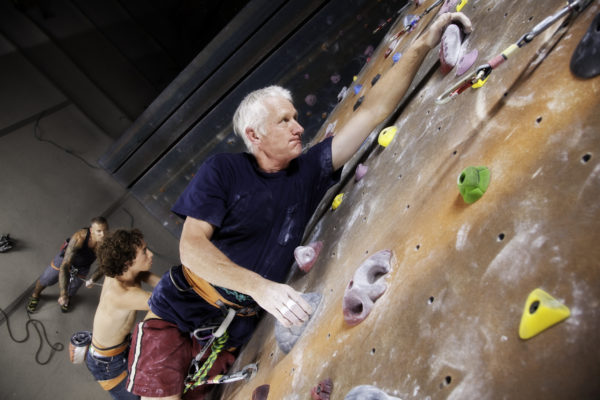
As most parents will attest, we are constantly amazed by the things our children attempt/accomplish, especially at an early age. Watching them go makes it impossible not to wonder, “How do they have so much energy? Does aging actually slow us down?”
My latest experience of amazement came on our trip to Maine, as I watched (and attempted to chase) my daughter running down Blue Hill Mountain.
As I reflected on my potential for loss of life or lib, it got me thinking: When do we stop sprinting down hills? And for that matter, when do we slow down in all aspects of our daily movement practice?
Many of us would probably say that we notice this change as we get older.
My next question: Do we slow down because we age, or do we age because we slow down?
Who says we have to stop running down the mountain just because we are not 4 years old?
Speed Work Matters
In previous blogs, we discussed the benefits of speed training (known as HIIT, or High Intensity Interval Training).
Here’s what you need to know:
- HIIT causes a dramatic shift in the rate of energy depletion in the body, as compared to regular cardio.
- Both intensity and duration of training impact our body’s ability to adapt to this type of exercise.
- Intensity of the stimulus is more important than duration.
- HIIT recruits more muscle fibers into the exercise, forcing our muscles to free up our stored up energy faster.
- It increases mitochondrial density in muscles (improving our ability to produce energy).
- HIIT is great for cardiovascular health, improving the structure and strength of our hearts.
- Contrary to popular belief, with proper medical oversight, HIIT is safe for those with pre-existing conditions, such as heart disease and diabetes.
Introducing Speed to Our Workouts
Many of us go to the gym regularly, so why don’t we implement more speed work into our routines?
The easiest way to do this is by incorporating it into our Warm Ups. The goal of the warm up is to efficiently prepare the body for activity. Per the American Heart Association, a warm up achieves this goal by dilating your blood vessels, ensuring that your muscles are well supplied with oxygen.
It also raises your muscles’ temperature for optimal flexibility and efficiency. While our kids may spend all day in a state of “warm up,” the rest of us desk jockeys may need 5-10 minutes to knock the rust off of the joints with some speed work warm up movements.
Examples of speed-based warm ups:
- Jumping Jacks: this tried-and-true exercise is a sure way to get your heart pumping. 30 seconds of this movement provides and introduction to jumping that paves the way for higher impact movements to come.
- Hopping: While you may feel silly doing it, hopping around is another great way to prepare your body for exercise by recruiting all of those fast-twitch fibers. If Hopping isn’t for you, grab a rope and try doing 30 second intervals jumping rope.
- Medicine Ball Tosses: There are many ways to use Med Balls when warming up, so check out this video I made highlighting some of our favorites at TJC-Skyline. Start with 2 sets of 6 repetitions for each movement.
Turning Speed Into Strength
Using speed as a component of strength training can be beneficial as it improves your ability to produce power with each movement.
Power is technically defined as the rate at which work is done. As it related to exercise, power is the ability to generate lots of force in a short period of time.
As it relates to the real-world, power is the ability to keep up with your 4-year-old daughter!
3 Pillars for Age-Defying Strength Training
- Plyometrics – these movements involve using your body weight to improve your power output. It works on your body’s stretch-shortening cycle, or your ability to transition between eccentric to concentric phases. In other words, it helps you more easily “control the negative, then explode out of it”. Examples of plyometric activities include hopping, skipping, jumping, throwing and swinging.
- Speed Strength – These movement involve scaling back your regular weights to include a speed focus. Modifying weight and reps allows you to focus on maintaining maximal speed of movement across the entire set. We recommend 3-5 sets of 3-5 repts with 40-60% of your 1-rep maximum. An example would be to dial your Deadlift load by 50% and work on how well you can perform a repetition while focusing on your speed and control.
- Complex Sets – These sets involve a strength exercise, immediately followed by a plyometric, or speed-strength movement. For example, a Deadlift followed by a Kettlebell Swing. The rationale behind this approach is that the strength exercise primes the nervous system for explosive movement through the recruitment of more muscle fibers. We recommend going heavy (3-5 reps), resting for 10 seconds, then going heavy again (3-5 reps) and resting for a long period (3 minutes).
This may be a lot to digest, so feel free to head over to my Blog and check out more videos and articles on this subject!
Want to be checked out by me, or any of our Orthopedic Residency graduate therapists? Click the link below:
Written by Dr. Daniel Alcorn, DPT at TJC-Skyline, check out his Blog here.









